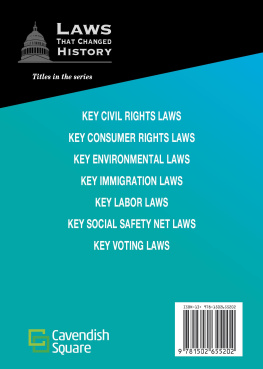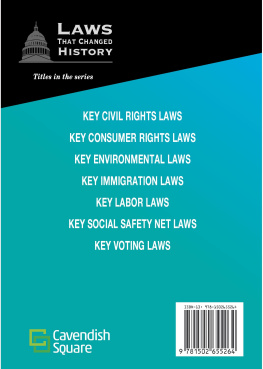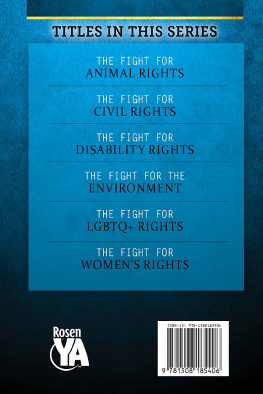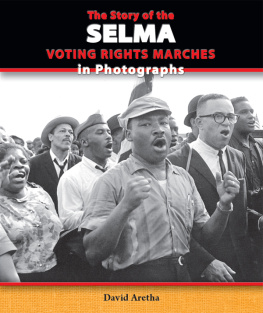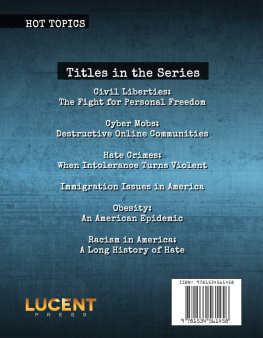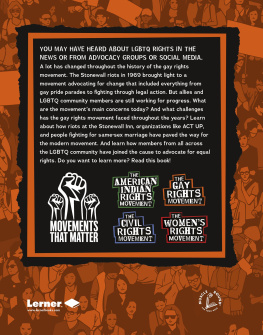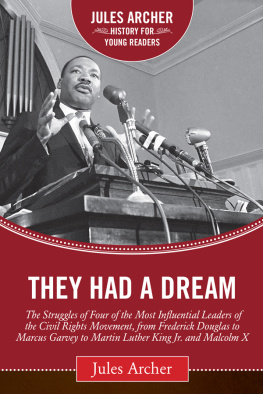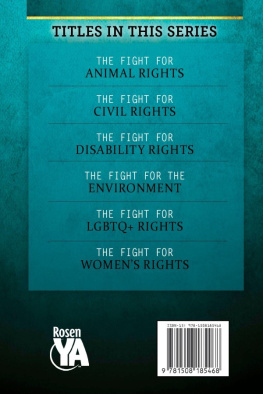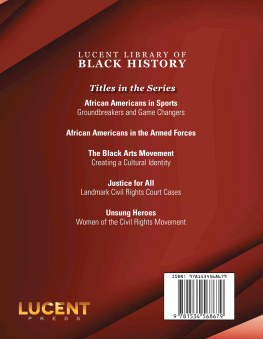
Published in 2020 by Cavendish Square Publishing, LLC
243 5th Avenue, Suite 136, New York, NY 10016
Copyright 2020 by Cavendish Square Publishing, LLC
First Edition
No part of this publication may be reproduced, stored in a retrieval system, or transmitted in any form or by any meanselectronic, mechanical, photocopying, recording, or otherwisewithout the prior permission of the copyright owner. Request for permission should be addressed to Permissions, Cavendish Square Publishing, 243 5th Avenue, Suite 136, New York, NY 10016. Tel (877) 980-4450; fax (877) 980-4454.
Website: cavendishsq.com
This publication represents the opinions and views of the author based on his or her personal experience, knowledge, and research. The information in this book serves as a general guide only. The author and publisher have used their best efforts in preparing this book and disclaim liability rising directly or indirectly from the use and application of this book.
All websites were available and accurate when this book was sent to press.
Cataloging-in-Publication Data
Names: Ohnaka, Kathryn.
Title: Key civil rights laws / Kathryn Ohnaka.
Description: New York: Cavendish Square Publishing, 2020. | Series: Laws that changed history | Includes glossary and index.
Identifiers: ISBN 9781502655202 (pbk.) | ISBN 9781502655219 (library bound) | ISBN 9781502655226 (ebook)
Subjects: LCSH: Civil rights--United States--Juvenile literature.
Classification: LCC KF4750.O36 2020 | DDC 342.7308--dc23
Printed in the United States of America
Photo Credits: Cover, p..
CONTENTS
Introduction
L ook around you. Think about your classroom, your job, your neighborhood, your friends, and the people who live in your community. Think about the different origins, races, genders, and identities of those people. How many are different from you? How are they different? We have such diversity in our communities now, but if you had lived 100 years ago, your community would have looked very different.
Discrimination is the refusal of equal rights to someone based on their race, gender, immigration status, or sexual or gender identity. Not so long ago in Americas history, people of color, women, Native Americans, and people of different gender identities and sexual orientations were not given the same rights as their white male counterparts. Throughout history, people of color have faced slavery, loss of land and property, lack of a voice in the government, and lack of jobs, and they have been refused entry to places such as restaurants and schools. In the past, women and people of color couldnt vote. Native Americans lost their land, and they still fight for it and their voting rights today. Before the 1960s, black people could not use the same facilities, such as schools, restaurants, and pools, as white people. In recent years, gay people have fought for their rights to be married and have the same health care as heterosexual people. Most recently, transgender people have been fighting for the right to access the bathroom that matches their identity and to participate in the same jobs as cisgender people, such as serving in the military. Think about your community now. Who faces discrimination? Is it over, or do we still have work to do?
Much of our history has been spent arguing about whose voice counts in our society. From voting and job opportunities to even sharing the same facilities, the battle for civil rights has been a long one. It took time, protests, court hearings, and arguments within the government to create the laws that protect our citizens today. However, the fight isnt over; groups still fight for the rights to vote, to own land, and to have the same jobs and protections as others. This book will discuss the key laws in the fight for civil rights that grant equality to Americas citizens, and it will consider the struggles that still exist today.
Think about your life now. Do you have everything you need? Do you have a voice in your society, the ability to make your own career and medical choices, and the right to be with the person you love? How bad would your life have to be for you to face violence or prison, endure hunger strikes, walk across the country, or take over a prison to draw attention to your needs? How far would you go to ensure equality for yourself, your family, and your friends?
Now think about the people around you. What did they fight for? What do they fight for today? Are they equal?
CHAPTER
1
Americas Early Days: Who Had Rights?
I n 1776, the Declaration of Independence declared, We hold these Truths to be self-evident, that all Men are created equal, that they are endowed by their Creator with certain unalienable Rights, that among these are Life, Liberty, and the Pursuit of Happiness. These iconic words were not completely true. While the words were revolutionary for their time, by the word men, they meant only white men. Excluded from the pursuit of happiness were people of color, women, and Native Americans. As white landowners expanded their land and power across America, others were forced from their land, forced to work with less pay or as slaves, and denied a voice in the government.
Slavery
In Americas earliest days, slave traders abducted people from Africa and brought them via ship to America to be sold as slaves. The first slaves arrived in America in 1619. Slavery is the practice of keeping people as property and forcing them to work without pay. Its estimated that 6 to 7 million slaves were brought to the United States. Slaves had no rights of any kind. They could not own land, vote, or travel freely. They could be separated from their families and sold to others. They were not allowed to go to school, nor were they allowed to read or write. If they refused to work or attempted to escape, they could be tortured or killed.

The original Declaration of Independence still exists today, kept at the National Archives in Washington, DC.
Though some people began to question slavery after the American Revolution, the practice remained until the American Civil War. Abolitionists, or people who disagreed with slavery, began to protest in the 1780s, and their movement gained traction in the early 1800s. They helped slaves escape to the North, which was a part of the United States where slavery was illegal. The government agreed this was a states rights issue, meaning that each state could decide for itself whether it would keep slavery legal or not. Eventually, as economic and social factors drove the country to split, the North and the South waged war with each other. The North was victorious, and it decided to make slavery illegal in order to cripple the Southern states and deprive them of their workforce.

During the civil rights movement, African Americans marched through cities, demanding equal rights when it came to voting, jobs, education, housing, and more.
Citizens vs. People in the Constitution
The US Constitution begins with We the People, and most of the amendments use this language as well. People refers to a human in the United States, while citizen refers to a person with legal American citizenship. The Constitution and the amendments refer to people, not to citizens; therefore, all people receive the basic rights from the Constitution. This language has allowed people throughout history, such as people of color and women, to argue that they are people and therefore should be given the same rights as their white male counterparts.
Next page
